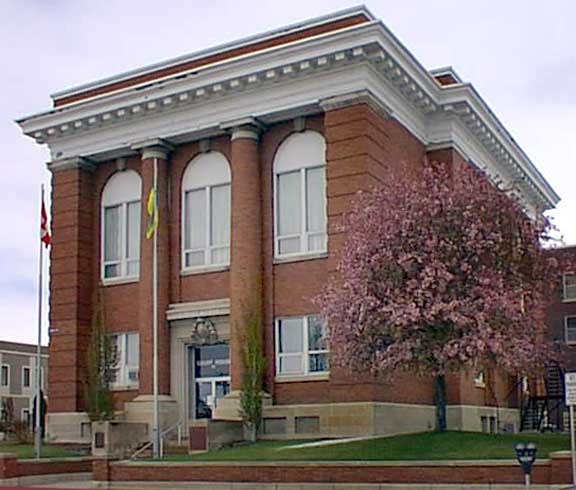Houses of Law : Moose Jaw |
 |
| FTLComm - Moose Jaw - May 16, 2000 |
 The primary difference between the United States and Canada is the basic premise of each country's constitution The underlying theme for American government is "Individual Liberty" and for Canada "Peace Order and Good Government." When it came to settling the vast interior of the continent Americans worked their way across the land fighting with the inhabitants and fighting with each other. North of the border the police (Northwest Mounted Police) arrived on the scene before the settlers to establish law and order and a legal presence to prevent intrusions by American criminals. So it is fitting that In Saskatchewan the Federal government would want a respected and dignified presence in the major communities and thus constructed a series of imposing court houses. We are going to take a look at a few of these examples of governmental architecture beginning with this one in Moose Jaw. Moose Jaw's federal court house is though impressive and somewhat imposing is one of the smaller ones in the province. All of them share a common appearance. They are set on land rising above the surrounding street and their face that they present to the world is in most cases on the South side of the |
 |
 building
and includes columns building
and includes columns and an imposing facade. The Moose Jaw building uses brick as its primary exterior building material even to form the huge centre columns based on limestone blocks, most likely quarried from Stonewall Manitoba. It was not he building that first caught my eye but the beautiful tree in front of it then I realised what a marvellous structure the court house was. With a building as impressive on the outside I wanted to see if the interior matched and went inside. I was challenged by a clerk who told me a good deal about the building and its history but would not let me take pictures inside and would not site reasons for this regulation. However, the inside is that of an old wood building with a certain level of creakiness to the floors. Though well maintained it was not created with the same grandness as its exterior. I was particularly impressed with the thickness of the |
 interior walls
which looked interior walls
which looked to be between twenty and eighteen inches thick. The high vaulting ceilings did not give you a feeling of grandness because of the cheap chairs in the court room and the rather blandness of the central hallway. In short, the interior is of a utilitarian nature and is devoid of ornamentation and stone work. The present use of the building is to provide court room facilities for the Court of Queen's bench. Across the street and visible in the picture below is the dull gray provincial court building that handles traffic court and all the mundane court work of a city like Moose Jaw. One overwhelming impression is that this structure was erected with the underlying expectation of remaining in place and serving for a very long time. Clearly, those who were managing the formation of this province expected things to last longer then their five year elected term and buildings like this one were built to last. When we consider public buildings today, be they schools or hospitals there is a temporary nature of them. Each seems to have been constructed to have a twenty-five year life and then be discarded or renovated into some other function. Our heritage seems to be rooted in a past where things were intended to be permanent yet somehow we have lost this view and picture every part of our society as "making do" until the community is abandoned and moved away. |
 |